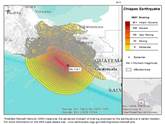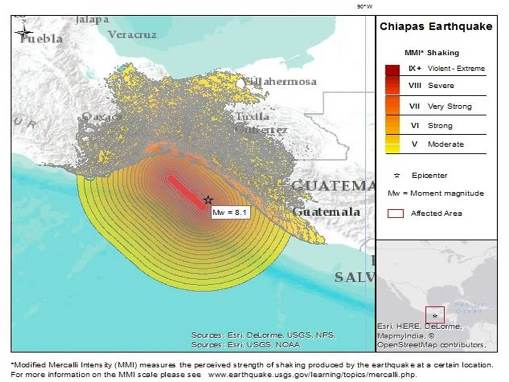

A magnitude (Mw) 8.1 earthquake struck in the Pacific Ocean southwest of Pijijiapan, Mexico, according to the U.S. Geological Survey (USGS). The quake occurred at 11:49 p.m. local time (04:49 UTC).
According to government officials, at least 33 fatalities have been reported. The earthquake damaged roads and buildings and the Pacific Tsunami Warning Center (PTWC) initially issued a tsunami warning, which has since been lifted, in Mexico with threats also facing El Salvador, Guatemala, Honduras and Costa Rica. According to the USGS, more than a dozen aftershocks ranging from 4.3 to 5.7 in magnitude have been recorded. Our first thoughts and concerns are with those directly affected by this event.
Hazard data illustrated in the CAT-i map was taken from GC AdvantagePoint®, Guy Carpenter’s web-based risk management platform. GC AdvantagePoint users can view impacted areas on any map as well as see how their portfolios were affected. Please contact your broker or cat modeling analyst for further information.
Geological Background
The Mw 8.1 earthquake occurred as the result of normal faulting at an intermediate depth, according to the USGS. Indications of a slip occurred on either a fault dipping shallowly towards the southwest, or on a steeply dipping fault striking northwest-southeast. The characteristics of this event suggest that it is likely an intraplate event within the subducting Cocos slab. The Cocos plate begins its subduction beneath Central America at the Middle America Trench, about 100 kilometers to the southwest of this earthquake, according to the USGS.
Impacts
It will take time to fully establish the scope and severity of the impacts of this event.
According to government officials, at least 32 fatalities have been reported in Mexico, with 23 fatalities reported in Oaxaca, seven in Chiapas and two in Tabasco. The President of Guatemala also advised one fatality was reported in Guatemala.
A number of buildings suffered severe damage in parts of southern Mexico, according to media reports. Some of the worst initial reports are from the town of Juchitan in Oaxaca state, where sections of the town hall, a hotel, a bar and other buildings were destroyed. Windows were shattered at Mexico City airport and power outages were reported in several neighborhoods, affecting more than one million people. Schools were closed in most of central and southern Mexico on Friday to allow authorities to review damage.
The PTWC originally issued a tsunami warning, advising that tsunami waves of more than three meters (nine feet) were possible along the coasts of Mexico, with threats also facing El Salvador, Guatemala, Honduras and Costa Rica. Some coastal areas were evacuated as a precaution. The PTWC reported the recorded tsunami waves that actually reached the Mexican coast were only 0.7 meters high.
There was no tsunami threat for American Samoa and Hawaii, according to the U.S. Tsunami Warning System. The national disaster agency of the Philippines put the country's eastern seaboard on alert, but no evacuation was ordered, according to media reports.
More than a dozen aftershocks ranging from 4.3 to 5.7 in magnitude have been recorded, according to the USGS. The President of Mexico advised more aftershocks were likely and also advised people to check their homes and offices for structural damage and for gas leaks.
Sources: USGS, Reuters News, PTWC, BBC News
Guy Carpenter publishes CAT-i reports for major natural catastrophes worldwide. These reports cover catastrophes including worldwide tropical cyclones, earthquakes, major UK and European floods and any other natural event that is likely to incur a significant loss to the (re)insurance industry. Please email CAT.i@guycarp.com if you wish to be added to the free email distribution list.
Guy Carpenter compiles RISK-i reports for major technological or man-made events worldwide. These reports cover risks to property, transport and life including explosions, fires, crashes, engineering disasters and terrorist attacks that are likely to incur a significant loss to the (re)insurance industry. Please email RISK.i@guycarp.com if you wish to be added to the free email distribution list.